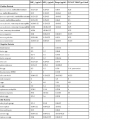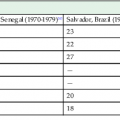Edward E. Walsh
Acute Bronchitis
Acute bronchitis refers to a clinical syndrome distinguished by a relatively brief, self-limited inflammatory process of large and mid-sized airways not associated with evidence of pneumonia on chest radiography. It is characterized by a dry or productive cough of less than 3 weeks’ duration, is most prevalent in winter, and is primarily caused by viruses. This definition does not pertain to acute exacerbations of chronic bronchitis, a clinical syndrome also frequently associated with viral infection but in which bacteria play a more important role (see Chapter 67). It should also be distinguished from acute bronchiolitis, a clinical syndrome involving small airways most closely linked to respiratory syncytial virus (RSV) and human metapneumovirus (hMPV) infection in infants (see Chapters 160 and 161).
Acute cough is one of the most common reasons for physician visits in all age groups.1 Incidence data may be imprecise because symptoms overlap considerably with those of the common cold, pneumonia, and asthma. Estimates from the National Health Interview Survey of U.S. households have found that overall, 5% of persons annually report physician-diagnosed acute bronchitis, with highest rates during the winter months and in those younger than age 5 years.2 Studies from the United Kingdom have reported similar rates of 54 per 1000 persons, ranging from 36 per 1000 in younger men to 225 per 1000 in those older than 85 years of age.3,4
Microbial etiology
Despite failing to uncover a specific pathogen in most case series, acute bronchitis is believed to be most commonly caused by a wide range of viruses (Table 66-1). Approximately 10% or less of cases are attributed to bacterial pathogens, principally Mycoplasma pneumoniae, Chlamydia pneumoniae, and Bordetella pertussis. However, the recent increase in pertussis cases among adolescents and adults should be considered when evaluating illnesses. The relative proportion of cases caused by different pathogens varies according to age and the season studied but, importantly, is also influenced by the diagnostic methods used. Molecular tests, rather than standard culture, identify a greater number and wider range of viral pathogens, especially in adults, in whom many illnesses represent reinfection with common pediatric viruses (RSV, hMPV, parainfluenza viruses) or infections with newly discovered pathogens such as parainfluenza 4 and bocavirus.5–8 Many of these infections in adults are associated with low virus shedding.6,7 Furthermore, at presentation to a physician, virus shedding may have already ceased. Influenza A and B viruses are most closely associated with winter outbreaks of acute bronchitis in both children and adults because of a high relative incidence of infection and the efficiency of influenza virus to infect and damage bronchiolar epithelial cells.3,8–10 Although cough associated with most coronavirus and rhinovirus infections is commonly caused by postnasal congestion, these agents, including recently identified strains of rhinovirus and coronavirus, including severe acute respiratory syndrome, can infect the lower airway, causing acute bronchitis.11–14 The higher temperature of lower airways was considered inhospitable to rhinovirus replication; however, recent evidence has convincingly documented virus presence in bronchiolar epithelial cells, although cytopathology is less than that with influenza virus infection.13 Although found less frequently than other viruses in the general population, adenoviruses, including the recently identified adenovirus type 14, and adenovirus types 4 and 7, are important causes of bronchitis in military recruits.8,15 Enteroviruses, primarily echovirus and coxsackievirus, can cause acute bronchitis. Simultaneous infection with two or more viruses occurs in 10% to 30% of cases, as is frequently the case with bocavirus infection. Worldwide, measles virus remains an important respiratory tract pathogen causing cough during the early prodromal phase; especially vulnerable are malnourished children in developing countries lacking resources for vaccination.16 Although herpes simplex virus is commonly identified in respiratory secretions of patients with respiratory illness and is generally considered to be clinically insignificant, it has been associated on occasion with acute hemorrhagic tracheobronchitis in normal persons and has been described in critically ill intubated adults.17 Although occasionally involving the lower airways, infection with human papillomavirus types 6 and 11 produces symptoms of hoarseness, stridor, and chronic cough.18
TABLE 66-1
Viral and Bacterial Causes of Acute Bronchitis
| PATHOGEN | SEASONALITY | COMMENTS |
| Influenza viruses | Winter | Local epidemics last 6-8 wk during which clinical illness of cough and fever has high predictive value; laboratory diagnosis readily available; early neuraminidase inhibitor therapy effective |
| Rhinoviruses | Fall and spring | Most frequent cause of common cold syndrome; immunity is serotype specific |
| Coronaviruses | Winter to spring | Causes common cold syndrome; newer strains are difficult to culture and require RT-PCR for diagnosis |
| Adenoviruses | Year-round, winter epidemics | High attack rates in closed populations such as persons living in military barracks or college dormitories; serotype-specific immunity |
| Respiratory syncytial virus (RSV) | Late fall to early spring | Attack rates approach 75% in neonates, 3%-5% in adults; associated with wheezing in all age groups; rapid antigen test accurate in children but requires culture or RT-PCR to diagnose in adults |
| Human metapneumovirus (hMPV) | Winter to early spring | Associated with wheezing in adults and in infants; difficult to isolate in tissue culture and often requires RT-PCR |
| Parainfluenza viruses | Fall to winter | Similar to RSV and hMPV, parainfluenza viruses primarily pediatric pathogens but can cause severe acute disease in some adults |
| Measles virus | Year-round | Can cause respiratory disease in malnourished children; illness causes transient immune suppression |
| Mycoplasma pneumoniae | Year-round, fall outbreaks | Long incubation period (10-21 days) results in staggered epidemic pattern in families; nonproductive persistent cough typical; diagnosed by IgM serology; treated with macrolide, quinolone, or tetracycline antibiotics |
| Chlamydia pneumoniae | Year-round | Associated with sinusitis; diagnosis by RT-PCR not readily available |
| Bordetella pertussis | Year-round | Severe illness in nonimmunized children; illness milder in partially immune adults can be associated with prolonged cough; adults often reservoir for epidemics; early therapy with antibiotics can reduce spread |
RT-PCR, reverse-transcriptase polymerase chain reaction.
Mycoplasma pneumoniae, C. pneumoniae, and Bordetella pertussis are the bacteria most associated with acute bronchitis, implicated in perhaps 10% of cases.3 Cough caused by these agents, especially B. pertussis, may persist in some cases for several months. Recently, Bordetella holmesii has been recognized as a cause of pertussis syndrome (see Chapter 232). In a recent acellular pertussis vaccine trial in adults, the incidence of pertussis was 0.7% in the placebo group.19 However, the number of cases in adults has been increasing in recent years, attributed to incomplete vaccine uptake as well as failure of the vaccine to induce durable immunity.20 This has resulted in a recommendation to provide a vaccine booster dose to adults and pregnant women (see Chapter 321). Bordetella bronchiseptica, a canine pathogen, can occasionally cause disease in humans, especially those who are immunocompromised.21 Streptococcus pneumoniae, Haemophilus influenzae, and Moraxella catarrhalis (formerly Branhamella catarrhalis) have not been conclusively demonstrated to cause acute bronchitis, despite their implication in postviral pneumonia and chronic bronchitis. Although many viruses enhance bacterial adherence to respiratory epithelial cells in vitro, the actual incidence of postviral bacterial infection in clinical situations has not been well defined.
Pathogenesis
The pathogenesis of acute bronchitis is the result of a combination of direct cytopathology of the pathogen and host immune response. Because cell tropism and pathogenic mechanisms vary for each of the viruses, it is not surprising that the location and extent of cytopathology in the airways also varies. Histopathologic changes in the airways during infection are best characterized for influenza virus.10,11,22,23 In a recent autopsy series of 47 children with fatal influenza, submucosal congestion, hemorrhage, mononuclear cell infiltration, and epithelial necrosis were noted in 50% of cases.23 Similar findings have been reported in adults, along with occlusion of airways by desquamated necrotic debris.22 In less severe influenza, bronchoscopic examination reveals only mild inflammatory changes.24 RSV has also been demonstrated to infect terminal bronchiolar lining cells with extensive debris occluding the lumen in infants, but similar data are lacking in adults.25 Rhinovirus, which is primarily associated with upper respiratory common cold symptoms, produces patchy infection of bronchial epithelial cells up to 15 days after experimental challenge.13
There is ample evidence that immune responses contribute significantly to disease pathogenesis in acute bronchitis. The innate immune response, characterized by virus-induced release of proinflammatory cytokines and chemokines by respiratory epithelial cells and immune cells, contributes to systemic and local symptoms. Early after infection with influenza, type I interferons, tumor necrosis factor, and interleukin-6 can be detected.26 In experimental influenza virus infection, symptoms correlate temporally with the kinetics of cytokine secretion.27 Cytokine induction by rhinovirus may also explain the important role that this virus plays in asthma episodes.28 The immune response is thought likely to be responsible for the prolonged airway hyperreactivity that can be demonstrated for up to 6 weeks after influenza or RSV infection in normal adults.29 Among the bacterial causes of acute bronchitis, B. pertussis is unique in that its expression of toxins may play a role in clinical symptoms, including the prolonged characteristic cough. However, a defined and specific pertussis “cough” toxin has not yet been identified.
Stay updated, free articles. Join our Telegram channel

Full access? Get Clinical Tree








